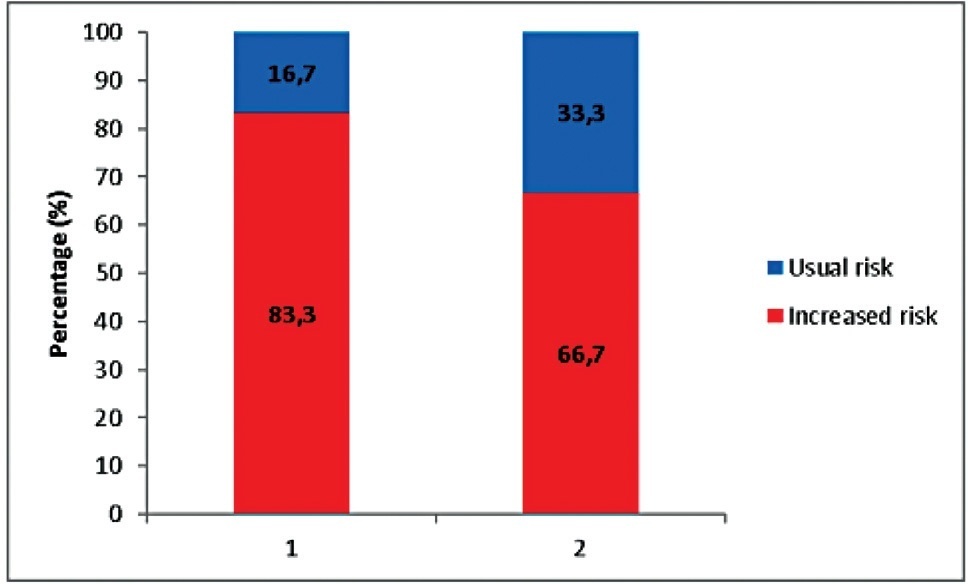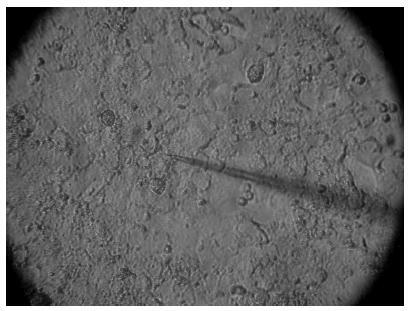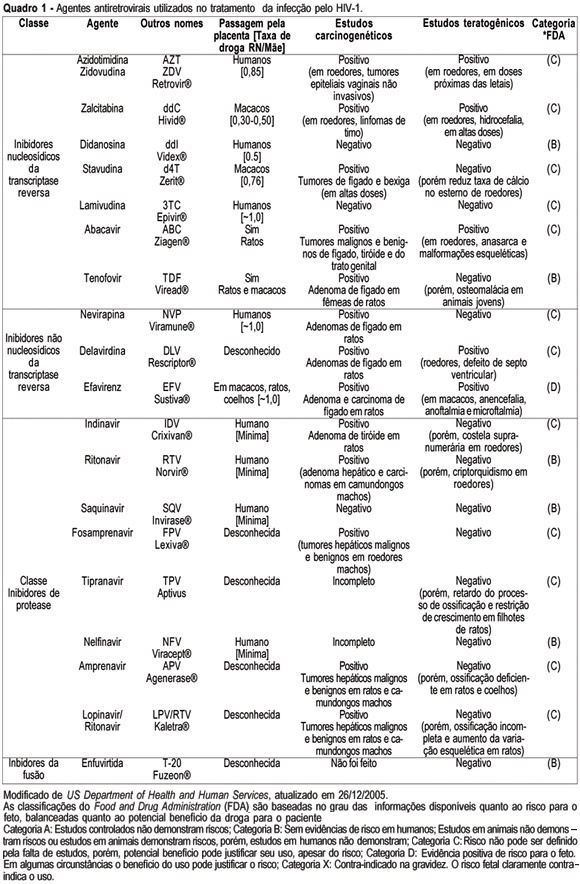Summary
Revista Brasileira de Ginecologia e Obstetrícia. 2004;26(1):76-76
Summary
Revista Brasileira de Ginecologia e Obstetrícia. 2004;26(1):76-76
Summary
Revista Brasileira de Ginecologia e Obstetrícia. 2022;44(8):761-770
The study aimed to characterize the clinical, histological, and immunohistochemical profile of women with invasive breast cancer, according to the risk for Hereditary Predisposition Breast and Ovarian Cancer Syndrome in a Brazilian population.
This is a retrospective study performed from a hospital-based cohort of 522 women, diagnosed with breast cancer treated at an oncology referral center in the Southeast region of Brazil, between 2014 and 2016.
Among the 430 women diagnosed with invasive breast cancer who composed the study population, 127 (29.5%) were classified as at increased risk for hereditary predisposition to breast and ovarian cancer syndrome. There was a lower level of education in patients at increased risk (34.6%) when compared with those at usual risk (46.0%). Regarding tumor characteristics, women at increased risk had higher percentages of the disease diagnosed at an advanced stage (32.3%), and with tumors > 2cm (63.0%), with increased prevalence for both characteristics, when compared with those at usual risk. Furthermore, we found higher percentages of HG3 (43.3%) and Ki-67 ≥ 25% (64.6%) in women at increased risk, with prevalence being about twice as high in this group. The presence of triple-negative tumors was observed as 25.2% in women at increased risk and 6.0% in women at usual risk, with the prevalence of absence of biomarkers being 2.5 times higher among women in the increased risk group.
From the clinical criteria routinely used in the diagnosis of breast cancer, the care practice of genetic counseling for patients at increased risk of hereditary breast cancer in contexts such as Brazil is still scarce.

Summary
Revista Brasileira de Ginecologia e Obstetrícia. 2018;40(12):763-770
The aim of the present study was to provide a better understanding of the specific action of two follicle-stimulating hormone (FSH) isoforms (β-follitropin and sheep FSH) on the membrane potential of human cumulus cells.
Electrophysiological data were associated with the characteristics of the patient, such as age and cause of infertility. The membrane potential of cumulus cells was recorded with borosilicate microelectrodes filled with KCl (3 M) with tip resistance of 15 to 25 MΩ. Sheep FSH and β-follitropin were topically administered onto the cells after stabilization of the resting potential for at least 5 minutes.
In cumulus cells, the mean resting membrane potential was - 34.02 ± 2.04 mV (n = 14). The mean membrane resistance was 16.5 ± 1.8 MΩ (n = 14). Sheep FSH (4 mUI/mL) and β-follitropin (4 mUI/mL) produced depolarization in the membrane potential 180 and 120 seconds after the administration of the hormone, respectively.
Both FSH isoforms induced similar depolarization patterns, but β-follitropin presented a faster response. A better understanding of the differences of the effects of FSH isoforms on cell membrane potential shall contribute to improve the use of gonadotrophins in fertility treatments.

Summary
Revista Brasileira de Ginecologia e Obstetrícia. 2023;45(12):764-769
The aim of the present study is to compare the effectiveness of Arabin pessary and McDonald cervical cerclage on preterm delivery.
We conducted a retrospective analysis of data from patients who underwent either Arabin pessary or McDonald cerclage between January 1, 2019, and January 1, 2023. A total of 174 patients were included in the study, with 31 undergoing Arabin pessary and 143 receiving cervical cerclage using the McDonald technique in singleton pregnant women with cervical insufficiency, which applied between 14 and 22 gestational weeks. We included singleton pregnant women with normal morphology, and with normal combined test. The primary outcome was the impact of each method on preterm delivery (< 34 gestational weeks).
The weeks of cervical cerclage or pessary application were compatible with each other (p < 0.680). The pessary group had a statistically significant longer time to delivery compared with the Cerclage group (cerclage group mean 30.8 c 7.1 standard deviation [SD] versus pessary group mean 35.1 ± 4.4 SD; p < 0.002). A statistically significant difference was found between the pessary and cerclage groups in terms of delivery at < 34 weeks (p = 0.002). In patients with cervical length between 25 and 15mm and < 15mm, no significant difference was found between the pessary and cerclage groups in terms of delivery week (p < 0.212; p < 0.149). Regardless of the technique applied, no statistically significant difference was observed between cervical length and birth < 34 weeks.
Our study found that pessary use for cervical insufficiency is statistically more effective than cervical cerclage surgery in preventing preterm births < 34 weeks in singleton pregnancy.

Summary
Revista Brasileira de Ginecologia e Obstetrícia. 2021;43(10):765-774
To investigate depression and sexual function among pregnant and nonpregnant women throughout the COVID-19 pandemic.
A total of 188 women, 96 pregnant and 92 non-pregnant were included. The Beck Depression Inventory (BDI) and the Arizona Sexual Experience Scale (ASEX) were applied to the participants after obtaining sociodemographic data.
The depression scores of pregnant and non-pregnant women were similar (p = 0.846). We found that the depression scores were significantly higher among the group of participants who have lower economic status (p = 0.046). Moreover, the depression score was significantly higher among women who lost their income during the pandemic (p = 0.027). The score on the ASEX was significantly higher, and sexual dysfunction was more prevalent among women who have lower levels of schooling and income (p < 0.05). Likewise, the ASEX scores were significantly higher (p = 0.019) among the group who experienced greater income loss throughout the pandemic. Upon comparing the pregnant and non-pregnant groups, we detected that sexual dysfunction had a significantly higher rate among pregnant women (p < 0.001).
In times of global crisis, such as the current pandemic, low-income families have an increased risk of experiencing depression and sexual dysfunction. When we compared pregnant women with non-pregnant women, depression scores were similar, but pregnant women were at a 6.2 times higher risk of developing sexual dysfunction.
Summary
Revista Brasileira de Ginecologia e Obstetrícia. 2004;26(10):765-771
DOI 10.1590/S0100-72032004001000003
PURPOSE: to identify factors associated with the occurrence of hot flashes in climacteric women living in Campinas, São Paulo. METHODS: data bank secondary analysis of a cross-sectional descriptive population-based study. The selection of 456 women aged 45-60 years was done through area cluster sampling. Data were collected via home interviews using structured, pre-tested questionnaires provided by the International Health Foundation/International Menopause Society and by the North American Menopause Society and adapted by the authors. The analyzed variables were age, race, use of contraceptive methods and hormonal therapy, tubal ligation, body mass index, menopausal status, time since menopause, hysterectomy, and cigarette smoking. Statistical analysis was performed using the mean, median and the prevalence ratio (PR). Multiple logistic regression was performed using the stepwise selection process with a 95% confidence interval (95% CI). RESULTS: bivariate analysis showed that postmenopausal women (PR: 1.42, CI 95%: 1.06-1.90) and those who were submitted to hysterectomy (PR: 1.50, CI 95%: 1.05-2.14) had a significantly greater chance of presenting hot flashes. After applying multiple regression analysis, there was no significant association between hot flashes and any of the evaluated variables. CONCLUSION: results were consistent with previous studies. Many doubts still exist about which factors are associated with hot flashes.
Summary
Revista Brasileira de Ginecologia e Obstetrícia. 2005;27(12):768-778
DOI 10.1590/S0100-72032005001200010
Knowledge about the factors or situations that influence the vertical transmission (VT) of human immunodeficiency type 1 (HIV-1) has led to the implementation of strategies which have promoted a rate decline along the years, from 40% to less than 3% nowadays. One of the major advances in the area has been the prophylactic administration of zidovudine (AZT), in the prenatal phase (oral route), in the predelivery phase (intravenous route) and to the newborn (oral route). This intervention may reduce HIV-1 VT 68%, thus being the most effective isolated strategy used so far. In the chronological sequence of advances, it has been observed that a high viral load is the main risk indicator for this type of transmission. As AZT does not reduce the viral load and does not control the residual rate observed in HIV-1 VT, the use of prophylactic schemes using three antiretroviral drugs has been encouraged. Elective caesarean section completes the range of obstetric strategies with major impact on the reduction of HIV-1 VT. Its effectiveness is linked to the observation of the criteria for its indication: viral load assessed after the 34th week of pregnancy with levels over 1000 copies/mL, gestation over 38 weeks confirmed by ultrasonography, intact chorioamniotic membranes, and performed before labor has started. In cases where normal delivery is indicated, it should be remembered that prolonged chorioamniorrhexis, invasive manipulation of the fetus, delivery with instruments and episiotomy are situations to be avoided. Among the postnatal interventions considered important for the reduction of HIV-1 VT are: pediatric reception (this should be done by trained professionals, avoiding microtraumas in the mucosa during the sucking maneuvers, use of neonatal AZT (for a period of six weeks) and bottle feeding. Special attention should be given to the orientation for the mother, in order to prevent acute infection by HIV-1 in this period, what would markedly increase virus VT rate.
